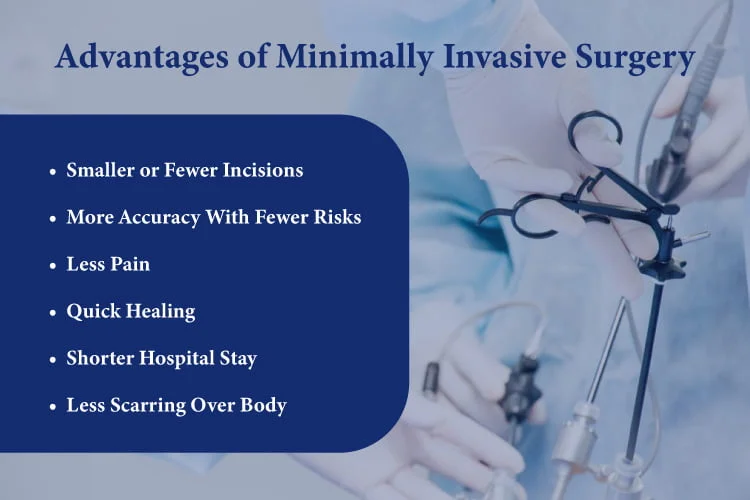How is Minimally Invasive Surgery Better than Traditional Open Surgery?

What is Minimally Invasive Surgery?
The medical industry has undergone numerous breakthroughs as the world progresses, and new inventions are made daily. One of the most promising instances of medical development is minimally invasive surgery. Nowadays, minimally invasive procedures are used to perform a variety of surgeries. The surgeons use advanced techniques during minimally invasive surgery to reduce adverse physiologic, metabolic, and cardiorespiratory effects. The patient’s body experiences fewer incisions, pain, and damage.
The medical industry has undergone numerous breakthroughs as the world progresses, and new inventions are made daily. One of the most promising instances of medical development is minimally invasive surgery. Nowadays, minimally invasive procedures are used to perform a variety of surgeries. The surgeons use advanced techniques during minimally invasive surgery to reduce adverse physiologic, metabolic, and cardiorespiratory effects. The patient’s body experiences fewer incisions, pain, and damage.
How Are Minimally Invasive Surgeries Done?
As minimally invasive procedures are safer and more effective than open surgeries, thus, surgeons prefer them. These procedures involve robotic techniques that make fewer incisions in the patient’s body. Here are the few most common minimally surgical procedures performed by surgeons.
Laparoscopy
Laparoscopy, or minimally invasive surgery, is usually performed through one or more small incisions using small tubes and tiny cameras, and surgical instruments. The camera transmits real-time images to a television monitor, enabling the surgeon to see the anatomy and carry out complex procedures with little harm to the patient.
Arthroscopic Surgery
In arthroscopic surgery, a surgeon makes a buttonhole-sized incision near and inserts an arthroscope, a thin, flexible fiber-optic video camera. Surgeons perform this surgery to check, identify, and occasionally treat joint injuries.
Endoscopy
Endoscopy is another technique that involves minimally invasive techniques. The digestive tract’s interior is viewable using an endoscope, a short, flexible tube containing light, and a camera lens at one end. With this technique, your doctor can examine and test the esophagus, stomach, and duodenum.
Robotic Surgery
Robotic surgery, often known as robotic-assisted surgery, is performed using a computer-like electronic operating station. Your surgeon operates a high-definition camera and robotic arms from this workstation to carry out the procedure. This surgery causes less pain and fewer cuts on the patient’s body.
Hysteroscopy
In hysteroscopy, a surgeon can examine the uterus with the help of a telescope without making any cuts. This is the main procedure doctor uses these days to assess uterine bleeding. Specialized hysteroscopes are also utilized for treatment in some situations, such as removing tumors, polyps, or scars.
Apart from the minimally invasive techniques mentioned above, surgeons perform various other procedures depending on the patient’s condition. These procedures involve bronchoscopy, Parathyroidectomy, Sigmoidoscopy, Natural orifice transluminal endoscopic surgery (NOTES), Video-assisted thoracoscopic surgery (VATS), and more.
Advantages of Minimally Invasive Surgery over Traditional Open Surgery
Most surgeons claim that minimally invasive surgery is better than traditional open surgery. It has various advantages over open surgery, and the most promising ones are the following.
Smaller or Fewer Incisions
One of the vital benefits of a minimally invasive technique is that it requires fewer incisions. In open surgery, a surgeon makes a bigger incision, for example, a six- to twelve-inch cut. While in minimally invasive technique, smaller incisions allow the surgeon to access body areas during robotic and laparoscopic surgeries because they employ small specialized equipment.

More Accuracy With Fewer Risks
In minimally invasive procedures, surgeons have a better view of the surgical site through special cameras. Thus, they can operate complex surgical procedures more accurately with fewer risks. Due to fewer incisions, infection risks to the surgical site decreases compared to open surgery. Besides this, blood loss risks also decrease because of a small surgical site.
Less Pain
Minimally invasive surgery gives less pain to patients than open surgery. The patient’s body experiences fewer traumas in these robotic surgical techniques because of smaller instruments. Thus, the patient doesn’t feel much pain after surgery. In contrast, larger wounds also hurt more which happens in open surgeries.
Quick Healing
Fewer wounds and incisions may make a patient’s recovery easy and quick. Post-operative discomfort and pain reduction and the patient also requires less medicine for healing. Some open surgeries call for cutting significant amounts of muscle and tissue. The patient feels more pain and discomfort as a result.
A standard abdominal hysterectomy, for instance, typically necessitates a healing period of 6 to 8 weeks, whereas a minimally invasive surgical treatment requires only 3 to 4 weeks for healing.
Shorter Hospital Stay
In traditional open surgeries, a patient has to stay longer than the surgery by minimally invasive techniques. Sometimes, the patient can go home even after spending just one night at the hospital. On the contrary, the patient stays for at least 3-4 days in the hospital for open surgeries. It’s one of the main reasons why patients also prefer minimal incisive surgeries like doctors.
Less Scarring Over Body
Smaller incisions mean fewer stitches and fewer stitches give fewer scars. In minimally invasive techniques, if an incision makes a scar, it will be so tiny to be noticed. While in traditional open surgery, a single big incision is enough to make a significant scar on the patient’s body. Usually, these scares fade out after a month or two.
Although minimally invasive surgeries are beneficial in many ways, you have to choose your surgeon or the medical center carefully. Dr. Abdul Baker is one of the top neurosurgeons utilizing minimally invasive techniques in North Texas. You can visit him if you live nearby.


Dr. Baker specializes in neurosurgery, neurosurgical spine surgery, neurotrauma, brain tumors, spinal tumors, and peripheral nerve damage treatment.